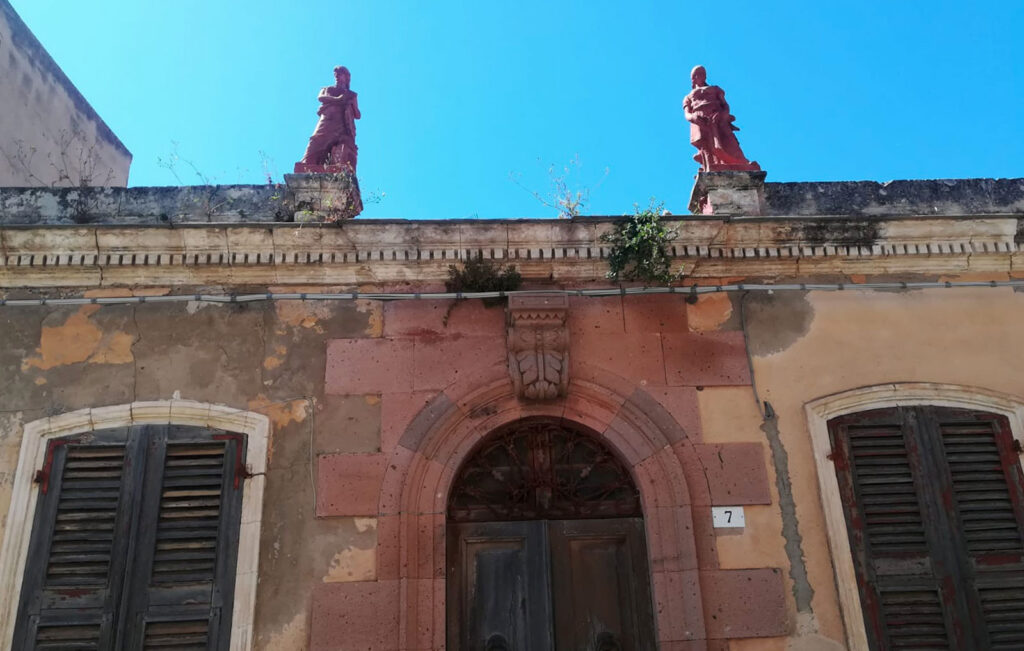
Ittiri
The Barony History
Don Bernardo Simò, a native of Majorca and regent of the Royal Chancery of the Kingdom of Sardinia, purchased and united in feud the fertile and lavish estates of Ittiri and Uri at the end of the 16th century.
Following that, the baronage passed to the Carrillo family, who were already lords of Bonorva and Torralba. With the death of Don Ignazio Carrillo Simò without direct successors in 1630, a long dispute began, with the Ledà (Ledda), counts of Bonorva and lords of Costaval, on one side, and the Hispanic De Miranda, former marquises of Valdecanzana and Torralba, on the other.
Despite the fact that the feud had not yet ended at the beginning of the 18th century, the Ledà had taken ownership of the fief, though the annuities of the two villages were seized in 1757. Nonetheless, Don Gerolamo Vaca Ledà, the nominal master of the territory, conspicuously altered all feudal encumbrances, bringing in new ones. The inept administration of the feuds caused a significant crisis in the production dynamics.
Letters of protest from Ithyrsis and Uri against the burden of taxes and levies accumulated in the royal archives beginning at least in 1760; the Ithyrian community directly appealed to Gianbattista Lorenzo Bogino, Minister for Sardinian Affairs, to ask for the redemption of the feud itself.
In 1783, land and villages were given to the eldest son, Antonio Manca Ledà, who was well known in both communities for his harshness, and whose habit of tossing bread to the pigs rather than delivering it to the fiefdom’s vassals was carried down through popular memory. The inhabitants of Coros’ two villas secretly smouldered with wrath against the barons.
The Revolution's prodromes in Coros
Ittiri and Uri’s major contribution to the Angioyan cause have their fundamental roots in the feud that engaged the two communities from the middle of the 18th century with the Ledà family, holder of the feud that united the aforementioned villages after a bitter dispute. Burdened by a tax yoke that the feud lords aggravated by committing scandalous abuses, the two communities engaged in a prolonged judicial fight with the Ledà family in the decades preceding the Sardinian Revolution.
During this period, Don Vincenzo Serra emerged as one of the most intriguing individuals of the second half of the 18th century in Sardinia, using his charisma, culture, and expertise to keep the feudal lord’s bullying in check.
A ruling class gathered around Casa Serra, a class capable of coagulating and animating the popular forces of the Ithyrians and Urians with the goal of emancipating them from feudal subjugation.
As a result of their disobedience, the mayors, community councils, and heads of families of Ittiri and Uri signed the so-called 'instrument of union' on March 17, 1796, on the patio in front of the parish church of San Pietro at Ittiri, swearing to 'no longer recognise any feudal lord'.
The 'instrument of union' as a means of liberation from feudalism
The so-called ‘Act of Redemption‘ of the two settlements of Ittiri and Uri, signed by notary Cosimo Serra on 17 March 1796, is one of the documents that best represents the echo of insurrection. The paper, written in Italian, emphasises the legal subversion and the desire of the locals to redeem their land. The priests, ‘knights and leaders’ of the villages of Ittiri and Uri signed the document. However, following Angioy’s loss and escape, a violent repression was carried out.
The viceroy commissioners’ most politically significant act was the forced revocation of these notarial acts, sworn by the communities of Logudoro: the papers were torn from the registers of the government archives and replaced by retractions, under threat of severe and heavy retaliation. The wind of revolution, however, did not die away, with people continuing to take up arms against the baronial factors or resorting to legal action to protest the ever-increasing number of violations.
Don Vincenzo Serra Delogu
One of the most representative individuals of the anti-feudal movement was Don Vincenzo Serra Delogu (1731–1803). Aware of the discontent of the people in his Baronia, he led a sizable contingent of commoners to overthrow Ledà on August 24, 1795, after yet another instance of his abuse of authority. The baron’s wealthy and well-stocked wheat depots were stormed, and the grain was divided equally among the thronging multitude, who were all suffering from severe hunger and oppression.
That same evening, the Uri people arrived, cramming approximately seven hundred people onto the plaza in front of the Ittiri church. Rifles and drums in hand, the mounted and infantry men advanced into the countryside in pursuit of the sound of drumming, determined to break the separating walls of the baron’s estates and crush its crops. The Ittiri and Uri villages gave the judicial officer—selected by the baron—a command to put an end to the fighting within eight days. Sincere candidates for public service were selected for judicial and administrative positions, while those with ties to the Ledà family were eliminated.
Being a prominent voice for the dissatisfaction of the Ittiri community, he saw the immense potential of Angioy’s proximity: at that time, the hero of the Sardinian Revolution had arrived in Sassari and would support the anti-Baronial campaign. Records detail how the Ittirians made every effort to assist the Angioyan rebels who had settled in the city; they also recount how the Ittirians never failed to stand with Alter Nos during his march into Cagliari, risking their lives to defend freedom.
Bibliography
G. Altea, M. Magnani, Storia dell’Arte in Sardegna. Pittura e Scultura dal 1930 al 1960, Nuoro, 2000
G. Biddau, Su alcuni documenti dell’Archivio di Piero Cao, in «Coracensis», 1994
G. Sechi, Uri e la sua storia, s.d.; s. l.
Uri, La storia, in Coolturistika: cinque paesi un territorio unico, Progetto ANCI 2011
G. Vulpes, I signori del feudo d’Ittiri e Uri, Sassari, 1999
G. Vulpes, Don Vincenzo Serra e la rivolta antifeudale ittirese, Sassari, 2008
G. Zanetti, I Cistercensi in Sardegna: le abbazie di S. Maria di Corte, di Paulis, e di Coros, in «Archivio storico sardo di Sassari», 1976 Vol. 2 (2)
Credits
A. Nasone, G. Ruggiu, S. A. Tedde


